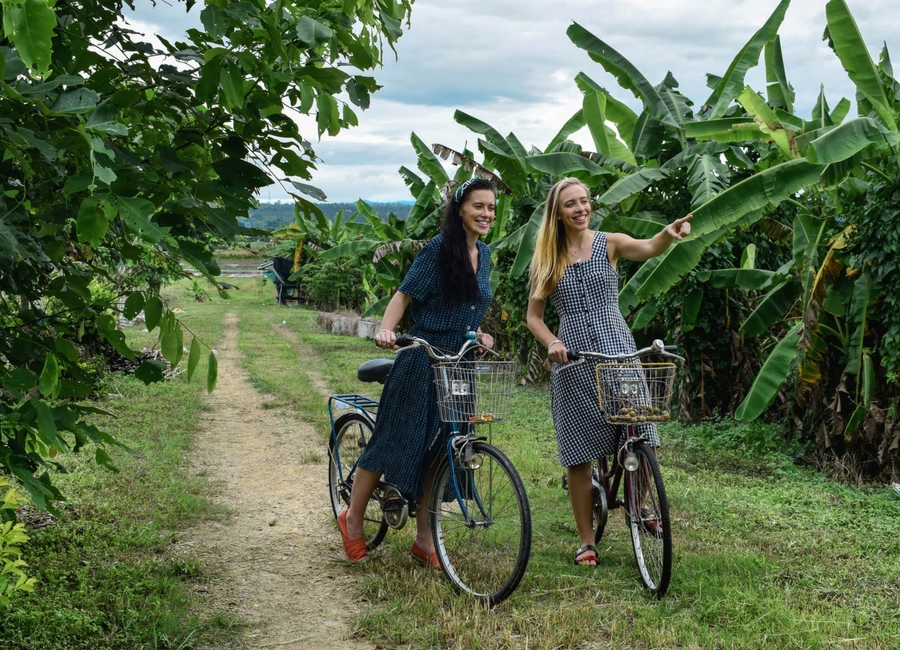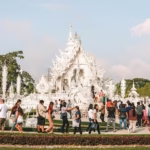Thailand’s beaches, jungle trails, and island bays still stop travellers in their tracks. In 2025, the question is simple. How can a trip support that beauty, not strain it? Eco-tourism offers a clear path. It means travel that protects nature, supports local people, and respects culture. In short, eco-tourism is travel with care.
This guide shares easy, up-to-date tips anyone can use, whether snorkelling in the south or hiking in the north. It also lists the best places for low-impact adventures and shows how to pick tours and stays that walk the talk. Expect simple actions, clear advice, and choices that benefit Thailand’s communities and wild places.
What Is Eco-Tourism in Thailand and Why It Matters in 2026
Eco-tourism is travel that leaves a place better than it was found. In Thailand, that means protecting wildlife in national parks, keeping coral reefs healthy, and cutting plastic waste on boats and beaches. It also means booking with local guides, eating local food, and keeping money in the communities that host visitors.
Thailand’s most popular parks and islands need careful visitors. Staying on marked trails keeps plants and soil stable. Quiet voices near wildlife reduce stress for animals like gibbons and hornbills. On the water, reef-safe sunscreen helps coral recover. Simple choices add up to cleaner beaches, healthier forests, and strong local jobs.
In 2025, Thailand is pushing for greener travel with new eco-routes, local projects, and stronger standards for hotels. Most accommodations are still catching up to global certifications, so smart booking matters. Ready to help on every day of the trip? Start with these simple habits.
Simple Responsible Travel Tips That Make a Big Difference
- Stay on marked trails and follow park signs.
- Pack out all trash, use refillable bottles, and skip single-use plastics.
- Use reef-safe sunscreen; never touch coral or stand on reefs.
- Keep voices low near animals; never feed wildlife.
- Choose small-group tours with trained local guides.
- Pick lodgings that reduce waste and save water, like towel reuse.
Respect Culture and Communities While You Explore
- Dress modestly at temples; remove shoes when asked.
- Ask before taking photos of people, markets, or ceremonies.
- Learn a few Thai phrases and greet with a smile.
- Buy local crafts and food; pay fair prices.
- Try homestays or community-run tours to share income with locals.
Pack Light and Plastic-Free for Islands, Forests, and Cities
- Bring a reusable water bottle and compact filter or purification tabs.
- Carry a small tote bag, utensil set, and metal straw.
- Choose mineral or non-nano reef-safe sunscreen; DEET-free repellent if possible.
- Pack quick-dry clothing, a hat, a rain jacket, and closed-toe hiking shoes.
- Add a small first-aid kit and power bank for longer treks.
Common Eco Mistakes to Avoid in Thailand
- Do not ride elephants or pose with drugged wildlife; choose observation-only sanctuaries.
- Do not buy shells, coral, or wildlife products.
- Do not litter or leave food scraps on trails or beaches.
- Do not fly drones in parks without permits; respect no-fly zones.
- Do not chase or crowd sea turtles, monkeys, or birds.
Best Eco-Friendly Destinations in Thailand (2025 Picks)
These picks balance strong nature, local leadership, and good low-impact tours. Check park hours, weather, and visitor limits before you go. Book with small, local operators. Keep the pace easy and the footprint light.
Khao Sok National Park: Ancient Rainforest and Floating Bungalows
- Highlights: Cheow Lan Lake, limestone cliffs, gibbons, and hornbills.
- Low-impact activities: guided hikes, night safaris, canoeing, and cave visits with permits.
- Responsible choices: stay in lodges with solar or waste systems; respect quiet hours.
- Safety: wear life jackets on boats; follow guide instructions; book certified guides.
- Timing: dry season brings clearer trails; rain increases leeches and slippery paths.
Why it stands out: Khao Sok’s karst towers and deep jungle feel primeval. Small-group night walks reveal dart frogs and civets while keeping stress on wildlife low. Floating bungalows can be eco-friendly when they manage waste and power well, so ask questions before booking.
Ko Lanta: Laid-Back Island With Marine Parks and Community Projects
- Highlights: national park trails, mangrove kayaking, quiet beaches, snorkelling.
- Low-impact activities: paddle in mangroves, sunset beach cleanups, village food walks.
- Responsible choices: choose refill stations, avoid single-use plastic on boats.
- Marine care: never stand on reefs; keep fins off the bottom; use reef-safe sunscreen.
- Timing: calm seas in dry months; shoulder season means fewer crowds.
Why it stands out: Ko Lanta’s pace encourages slow travel. The island has community-driven efforts like refill programs and beach cleanups. Choosing local boats and guides spreads income while keeping marine life safe.
Chiang Mai and Nearby Parks: Trails, Waterfalls, and Organic Farm Stays
- Highlights: forest hikes, waterfalls, night markets, craft villages.
- Low-impact activities: community-led treks, farm stays, cooking classes with local produce.
- Responsible choices: ask about group size limits and fair pay for local guides.
- Culture: temple etiquette and photo respect; learn simple Thai greetings.
- Weather: cooler months are best for hiking; pack layers for early mornings.
Why it stands out: Chiang Mai connects culture and nature. Day trips reach national parks with well-marked trails and ethical hill community treks. Farm stays show how organic methods cut chemicals while serving fresh, local meals.
Phang Nga Bay: Sea Kayaking Among Limestone Karsts
- Highlights: sea caves, lagoons, towering cliffs, birdlife.
- Low-impact activities: paddle-only tours, small groups, no engines in caves.
- Responsible choices: carry out all trash; do not feed fish or monkeys.
- Tides and timing: plan around tides and currents; choose early or late tours to avoid crowds.
- Safety: wear a PFD; listen to guides; protect dry bags and cameras.
Why it stands out: Kayaks glide into hidden lagoons at high tide, then back out with the falling water. Guides who avoid engines in sensitive zones protect mangroves and nesting birds. It is a peaceful way to see a world-class seascape.
Pai: Hot Springs, Waterfalls, and Slow Travel
- Highlights: mountain views, hot springs, canyon sunsets, cafes.
- Low-impact activities: guided treks, cycling, farm stays, and local food tours.
- Responsible choices: ride scooters only if trained; wear helmets; respect noise limits.
- Seasonal notes: dry months can be dusty; check air quality; consider off-peak visits.
- Community: support small eateries and handicraft stalls in villages.
Why it stands out: Pai rewards unhurried days. Cycling to waterfalls and small farms cuts emissions and supports family-run spots. Evenings stay quiet when visitors follow noise rules and stick to local curfew expectations.
How to Choose Eco Tours, Stays, and Transport in Thailand
With green claims everywhere, it helps to spot real action. Thailand’s sustainable tourism is growing, backed by new routes and policies. Still, many hotels have work to do to meet strong standards. These quick checks keep bookings honest and effective.
Spot Real Sustainability, Not Greenwashing
- Look for third-party standards like GSTC or Travelife, or clear policies on energy, water, and waste.
- Check for refill water, no single-use plastics, and wastewater treatment.
- See if the business hires and trains local staff and guides.
- Wildlife rules: no feeding, touching, or chasing animals; small group sizes.
- Read recent reviews that mention real practices, not just marketing claims.
Tip: A simple refill station, towel reuse, and a waste plan often signal real effort. Vague claims without details usually do not.
Smart Questions to Ask Tour Operators Before Booking
- What is the group size and guide-to-guest ratio?
- How do you protect wildlife and habitats during tours?
- How do you handle trash and wastewater on trips?
- How are local communities paid or included?
- Are guides certified and insured, and is safety gear provided?
If replies are detailed and friendly, that is a good sign. If answers are fuzzy, pick another operator.
Save Money and Emissions With Low-Impact Transport
- Use trains for long stretches; consider overnight sleepers.
- Choose public buses, shared minivans, or ferries instead of short flights.
- Walk or cycle in towns; cluster sights to cut rides.
- Combine nearby regions in one trip to reduce backtracking.
- Pack light to save fuel on boats and vans.
Example: Pair Khao Sok with Phang Nga Bay in one trip, then return by bus or train instead of flying twice.
Stay Healthy and Safe While Staying Green
- Carry travel insurance and a small first-aid kit.
- Hydrate often; refill bottles at safe stations or filter water.
- Sun safety: hat, UPF shirt, and reef-safe sunscreen.
- Respect weather alerts, currents, and park closures.
- Choose more plant-based meals to lower your footprint and support local produce.
Note: In parks with leeches or slippery trails, low-cut gaiters and sturdy shoes keep feet secure and happy.
One-Week Eco Itinerary Ideas for First-Time Visitors
These sample routes keep travel smooth and low-impact. Use public transport or shared transfers where possible. Leave room for rest and weather changes.
Southern Nature Loop: Khao Sok, Ko Lanta, and Phang Nga
- Day 1-2: Khao Sok hikes and lake tour with certified guide; stay in eco-lodge.
- Day 3-5: Ferry to Ko Lanta for snorkelling, mangrove kayaking, and beach cleanup.
- Day 6: Phang Nga Bay paddle-only cave tour; avoid feeding wildlife.
- Day 7: Rest day, local market visit, and slow travel back by bus or train.
- Notes: book small-group tours, bring reef-safe sunscreen and refill bottle.
Why it works: Distances are short and activities are water-based or on foot. Waste stays low with refill stations and plastic-free kits.
Northern Culture and Forest Route: Chiang Mai and Pai
- Day 1-3: Chiang Mai temples with etiquette, cooking class, and community-led trek.
- Day 4-5: Farm stay with organic meals; waterfall hike with local guide.
- Day 6-7: Pai hot springs, canyon sunset, and cycling to nearby villages.
- Notes: travel by bus or shared van; avoid elephant rides; pack layers for cool nights.
Why it works: Culture and nature blend without heavy transport. Spending more time in fewer places cuts emissions and stress.
Rainy Season Plan: Flexible, Fun, and Safe
- Pick activities that work in light rain: cooking classes, museums, craft workshops.
- Choose mangrove kayaking or short forest walks when storms pass; watch for slippery trails.
- Keep a light poncho and dry bag; avoid flash-flood zones and closed paths.
- Support local cafes and co-ops on heavy rain days.
- Build buffer time in case of delays.
Why it works: The plan suits shifting weather. Water-ready gear and flexible bookings keep the trip enjoyable and safe.
Thailand’s Eco-Tourism Outlook in 2025
Thailand is investing in greener routes and cleaner stays. Travellers aged 26 to 35 are driving demand for nature trips like kayaking and snorkelling. Less than one percent of hotels currently meet tough global standards, so asking smart questions still matters. The upside is big. Support for local guides, plastic-free habits, and reef-safe sunscreen all boost the country’s long-term health.
Conclusion
Small choices shape big outcomes. With simple habits and smart bookingtravellersers help protect Thailand’s reefs, forests, and villages. Pick one or two destinations from this list, choose small local tours, and follow the tips on trails, wildlife, and plastic. Share these responsible habits with friends so more trips become low-impact trips. Thailand stays beautiful when visitors help keep it that way.















